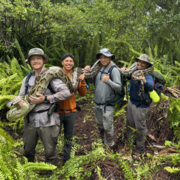Kristen Hart, Ph.D.
Kristen Hart is a research ecologist, focusing on population-level studies on the ecology of a broad array of herpetofauna and other wildlife in south Florida.
She leads several research programs and collaborates closely with other USGS, university, and National Park Service scientists. She has built a program of USGS cyclic- and reimbursable funded research; major funding has been provided from the US Fish and Wildlife Service, the US Army Corps of Engineers, the USGS Priority Ecosystem Studies Program, the USGS Coastal and Marine Geology Program, and the National Park Service. She works with rare, threatened, endangered, and invasive species of reptiles including Diamondback terrapins, loggerhead sea turtles, green sea turtles, hawksbill sea turtles, crocodilians, and Burmese pythons. She is based in Davie, FL and has field sites in both Everglades and Dry Tortugas National Parks in South Florida, Bon Secour National Wildlife Refuge (Gulf Shores, AL), and Buck Island Reef National Monument (St. Croix, U.S. Virgin Islands).
Education and Certifications
Ph.D., Ecology, Duke University, 2005
M.E.M. (Master's of Environmental Management), Coastal Environmental Management, Duke University, 1999
B.S., Boston College, Bachelor of Science, 1997













